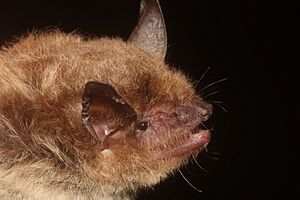Peninsular myotis facts for kids
Quick facts for kids Peninsular myotisMyotis peninsularis |
|
|---|---|
 |
|
| Conservation status | |
| Scientific classification | |
| Genus: |
Myotis
|
| Species: |
peninsularis
|
 |
|
The peninsular myotis (Myotis peninsularis) is a species of vesper bat. It is endemic to northwestern Mexico, found only within Baja California Sur state on the southern Baja California Peninsula. Its habitats include the southern Peninsular Ranges and deserts.
Taxonomy and etymology
It was first encountered in August 1896 by Loye H. Miller. It was described by Gerrit Smith Miller Jr. in 1898. It was previously considered a subspecies of the cave myotis, Myotis velifer. Its species name peninsularis is Latin in origin, meaning "of or connected with a peninsula."
Description
It is 91 mm (3.6 in) long. Its tail is 34 mm (1.3 in) long, and does not extend past the uropatagium. Its forearm is 39 mm (1.5 in) long.
Range and habitat
It is only found in southern Baja California.
Conservation
It is currently listed as endangered by the IUCN. It meets the criteria to be listed as endangered because it is only found to in three or four locations, its extent of occurrence is less than 4,000 km2 (1,500 sq mi), and its habitat is expected to decline in quality in extent in the future. Threats to this species tourist activities.


